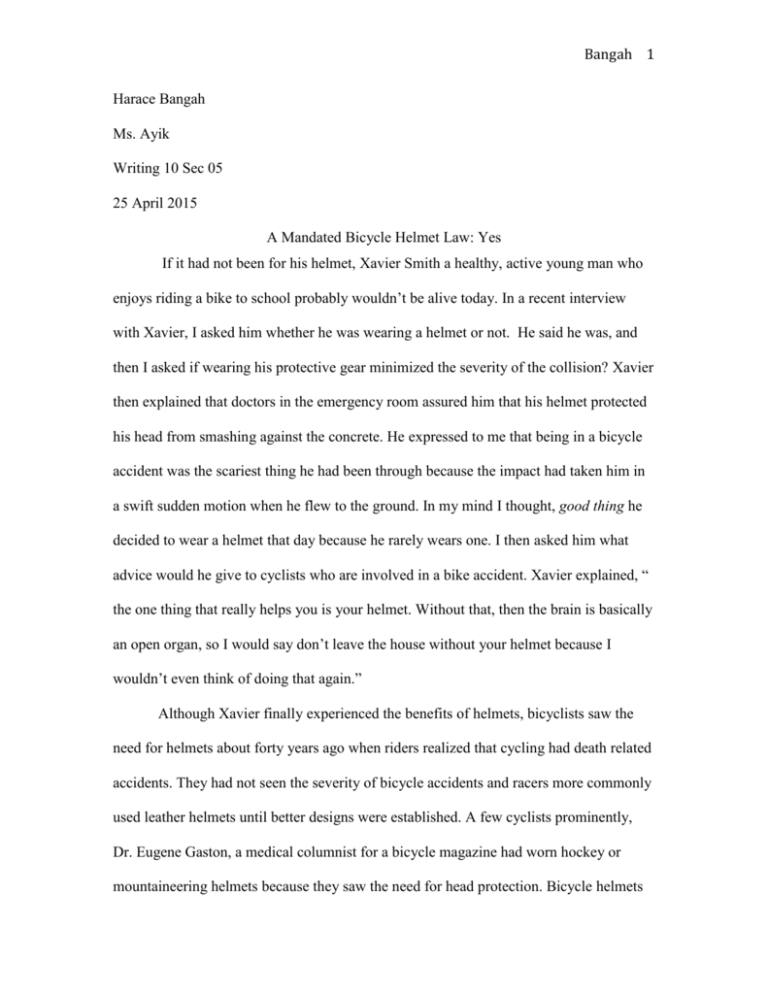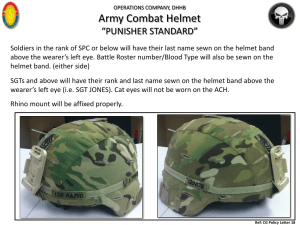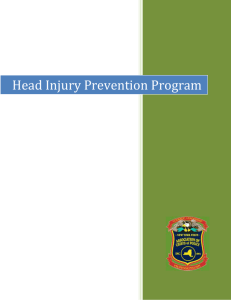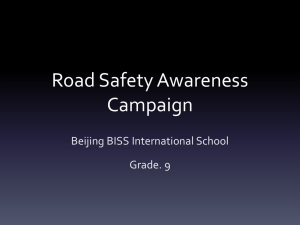Causal Essay (1)
advertisement

Bangah 1 Harace Bangah Ms. Ayik Writing 10 Sec 05 25 April 2015 A Mandated Bicycle Helmet Law: Yes If it had not been for his helmet, Xavier Smith a healthy, active young man who enjoys riding a bike to school probably wouldn’t be alive today. In a recent interview with Xavier, I asked him whether he was wearing a helmet or not. He said he was, and then I asked if wearing his protective gear minimized the severity of the collision? Xavier then explained that doctors in the emergency room assured him that his helmet protected his head from smashing against the concrete. He expressed to me that being in a bicycle accident was the scariest thing he had been through because the impact had taken him in a swift sudden motion when he flew to the ground. In my mind I thought, good thing he decided to wear a helmet that day because he rarely wears one. I then asked him what advice would he give to cyclists who are involved in a bike accident. Xavier explained, “ the one thing that really helps you is your helmet. Without that, then the brain is basically an open organ, so I would say don’t leave the house without your helmet because I wouldn’t even think of doing that again.” Although Xavier finally experienced the benefits of helmets, bicyclists saw the need for helmets about forty years ago when riders realized that cycling had death related accidents. They had not seen the severity of bicycle accidents and racers more commonly used leather helmets until better designs were established. A few cyclists prominently, Dr. Eugene Gaston, a medical columnist for a bicycle magazine had worn hockey or mountaineering helmets because they saw the need for head protection. Bicycle helmets Bangah 2 have protected riders now for decades. The first standard bicycle helmet was created in the 1970’s by the Snell Foundation. Snell is a helmet foundation that was created for William Pete Snell, an aspirant auto racer, who was killed in a racing event after his low quality helmet failed to protect him. The Snell memorial foundation aims to improve helmet construction and capability while encouraging development and usage of high quality helmets (BHSI). Technicians in the Snell lab assure high quality by repeatedly testing their products. These tests make sure in the event of an accident the helmet can provide physical protection to the head. A helmet is made to provide physical protection to the head in the event of a collision. Helmets are made with expanded polystyrene foam liners. This is important because on impact the line depletes the force of the impact to protect the cranium. The reason for anyone to wear a helmet is to absorb the impact of the crash. Ultimately, it comes down to the constraints of the design. The load on the skull has to be less than the damage load (Becker). Helmet models perform two extenuating functions. They disperse a localized outer force over a large area and then set an upper limit to the magnitude of the distributed force (Becker). Impact mitigation relies on the ability to absorb energy and the construction of the outer and inner foam liners. When you crash and hit a hard surface, the foam part of the helmet crushes, controlling the crash energy and the head’s stopping time by about six thousandths of a second (6ms) to reduce the peak impact to the brain. The helmet ensures the preservation of life by physically protecting the brain. The number of people who have died from a bicycyle accident have decreased overall , but the number of cylists killed due to not wearing their protective gear are greater than cyclists who utililized helmets. In the year 1994, 776 people died in the Bangah 3 United States due to the absence of a helmet in comparison to riders who did not use helmets who only experienced nineteen deaths (Haddon). Head protectors have even drastically decreased the number of deaths twenty years ago. In 2010, 600 bicyclists overall were killed and about 515,000 bike related injuries that requried emergency room treatment were reported (Kresnow). The majority of death related accidents caused by cycles occurred in childen who were under the age of 20. Children are less likely to wear helmets due to their apperance or style and in 2013, 464 people were involved in a fatal crash due to no helmet use (BHSI). Although that number has decreased, overall helmet use is still a necessity. A total of 127 people died compared to 464 people though they had their helmets. Some may say that 127 deaths is still a large number but that number is about 1/3 of the amount of people who died due to no helmets. The statistics of cycle accidents and their correlation to emergency room deaths have a positive linear correlation and the best way to preserve human life is to limit the severity of an accident by wearing a helmet. Riders who do not utilize helmets are risking severe injuries and tremendous potential costs, which may result in lifelong consequences or even death. As a community everyone should wear protective gear when riding a bike, but helmet law skeptics are predominately libertarians opposing helmet laws and riders who see helmet advocacy as an infringement upon personal rights. Many crtitcs opposed to a manadated bicycle helmet law say it goes against personal freedom and liberty, but the government has the right to take away liberty if it interferes with public safety. Some will ask, How am I a danger to myself or the public? According to Michael Bluejay, an award winning blogger, he states that drivers pass helmeted cyclists more closely than unhelmeted cyclists because unhelmeted cyclists seem more vulnerble (Bluejay). While Bangah 4 that is true to some degree, it doesn’t account for the increase or decrease in cycle accidents. Most bicycle accidents are precarious because injuries are dependent on circumstances beyond one’s control and victims usally end up in the emergency room. People opposed to the use of cycle helmets may not be aware of the costs of treating a bike accident victim. The cost of care for the average TBI patient is about one hundred and fifty thousand dollars in one year alone(Newsome).Cycling is a dangerous activity and the statistics of the number of bike related injuries and the medical bills that follow is a good enough reason for the government to impose a bike helmet law. Of course most libertarians would be opposed to a law that would require cyclist to wear helmets, but the amount of money and lives that will be saved by wearing one is greater than the cost of not wearing one. With the use of a helmet, riders have a better chance of surviving an accident, but a proposed bicycle helmet law has caused a heated controversy in the United States. Surveying undergraduates around the University of Merced campus, students expressed that their greatest fear of cycling was fear of a collision with an automobile. It is the single greatest impediment to getting more people on their bicycles. The numbers of accidents are increasing every day as more cyclists fill the emergency rooms (Kresnow). In Merced County alone there were a total of 112 total emergency room cases from 2006 to 2011 (Pedrozo). That equals about twenty five Injury cases a year involving cyclists who are involved in motor vehicle collisions. The cost of treating a brain injury victim is about six hundred thousand to two million dollars over a lifetime. With the potential costs and dangers so tremendous, there are still several reasons why a mandated helmet law has not been passed. Many citizens in society have agreed Bangah 5 with the systematic refusal of infringement on personal liberty. That is why gun laws, prohibition and other public safety issues have not been dealt with. People love their rights and freedom even if it costs them their well being. Another reason for the delay of a proposed law is because Merced County is struggling finiancially with the unemployment rate way above the national average and the averge income level below the national average. Policy making officials are hesitant to create a mandated bike helmet policy that will create a safer neighboorhood because it will cost the city more money. Police officers are more likely to not even enforce it because high priority crimes are at the top of their agenda (Davis). The local k-9 unit and bicycle patrol department does not enforce bicycle safety as of now even when they see riders without their helmets daily (Davis). Socities negligence to pay attetion to certain dangers is causing the injury and death of cyclists. Officers and educated scholars know better and their job should be to educate and protect the public from danger which extends to bicyle safety measures. Schools and Institutions also have a duty to the public to warn children about the risks of everyday activities without safety precautions. Life is valuable and riders who are not utilizing helmets are putting their lives at risk. Cyclists who choose not to wear a helmet increase their chances of having a tramatic brain injury.TBI usaully results from a violent blow or impact to the body which can lead to the dysfunction of brain cells, bleeding and in some cases death. Every year there are over a million people in the United Sates who suffer from a tramatic brain injury. According to the Mayo Clinic, collisions involving cars, motorcycles, bicycles or pedestrians are a common cause of Brain Injury. TBI is a major problem in the United States because it leads to disabling conditions and the privation of well being . According Bangah 6 to the Center for Disease Control, the effects of TBI include dysfunction of cognitive ability such as sustaining attention , concentratting on tasks at hand and remembering newly learned material. Depending on the severity of the accident sometimes large amounts of intricate information is unable to be processed. Victims who suffer from TBI have to pay expenses for the initial hospitilaztion fee, rehabilitation and often times long term care for disabilty(Newsome). The cost of cognitive rehabilitization is unaffordable for most americans. Merced county has a median income of 42,591 dollars which is about twenty thousand less than the rest of california( Thompson). Victims of brain trauma spend a lifetime paying for their medical treatment. Within the first six months of treatment a team of professionals are established to diagnose the severity of the impact and stabalize the brain. Ranging from nurses to neurologists, they each work to restore lost functional abilities. A team of staff will also provide adaptive devices or machines to stregenthen functional independence. Expenditures for these professionals and machines are astronomical. Treatment ranges from 90 to 270 days for mild to severe brain injury, and patients treated for more than two years will require double the cost and time(Ashley). After rehabilitation, the patient is discharged from the psychiatric facility and depending on the recovery stage, the patient can be disabled for the remainder of his lifetime. Disability is defined as having a limitation in any way or activity because of physical,mental or emotional problems. Disabilities often require long term care or lifelong assistance to perform activities of daily living. In 2006, disability associated health care expenditures accounted for 26.7 percent of all health care expenditures with state expenditures ranging from 598 milion to 40.1 billion dollars(Kresnow). People with Bangah 7 disabilities have needs and aspirations as diverse as any other group. They may need steps with handrails, accessible toilets, or surfaces that are firm and wheelchair accessible. The federal government spends more money each year on disability programs than it spends on food stamps and welfare combined(walt). The growing rate of disability is detrimental to the economy because the handicapped are unable to work while at the same time receiving money from the federal government. The effects of not wearing a helmet outweigh all the reasons why personal liberty should overule the decision of a mandatory bicycle helmet law for. Severe collisons can cause Traumatic Brain Injury and permanent disabilty which can be prevented by the use of protective gear. A mandated helmet law would be an effective policy because the main goal is the preservation of life and not to mention the amount of money the public will be saving. Riders can limit the severity of an accident and not have to pay for rehabilitation and long term care for brain injury.Brain Injury is complex and unlike most diseases it cannot be cured by surgery or pharmaceutical drugs. It requires the amount of money that can be spent in a lifetime and for this reason, a mandated bike helmet law is the best way to prevent cyclists from having to pay for such expenses. The use of helmets increase life expectancy for decades for those who crash and also prevents long term disability. Should all bicyclists be required to wear helmets? Yes, because wearing a helmet limits the severity of an accident and saves money that would be used on medical treatment and increases your chances of survival. Advocates and critics of a mandated helmet law can agree that avioding a crash is preferable to crashing in a helmet , but crashing in a helmet can increase the chances of surviving and maintaining a healthy lifestyle. Bangah 8 Works Cited Ashley, Mark, D.r. "Brain Injury Association of America’s Cost Estimates Bangah 9 on Cognitive Rehabilitation." - ProPublica. Brain Injury Association of America, 30 July 2009. Web. 09 Mar. 2015. Becker, Edward. "Helmet Testing." Snell Foundation. Snell Memorial Foundation, n.d. Web. 09 Mar. 2015. Bicycle Helmet Safety Institute. "Helmets: Bicycle Helmets." Helmets: Bicycle Helmets. National Bicycle Safety Network, n.d. Web. 07 Mar. Bluejay, Micahel. "What's Wrong with Bicycle Helmets?" What's Wrong with Bicycle Helmets? Bicyclesafe, June 2013. Web. 06 Mar. 2015. Davis, Offficer 2015 April 11. Personal Interview. Haddon, William Jr., M.D. "Pedestrians and Bicyclists." Fatality Facts. Insurance Institute for Highway Safety, n.d. Web. 07 Mar. 2015. Kresnow, Dellinger, M.J. "Head Injuries and Bicycle Safety." Centers for Disease Control and Prevention. Centers for Disease Control and Prevention, 28 Jan. 2015. Web. 06 Mar. 2015. Newsome, Curtis. "Sometimes There Is More to the Picture." Medical Expenses for a Traumatic Brain Injury. Newsome Melton LLP, n.d. Web. 08 Mar. 2015. Pedrozo, John, and Hubert Walsh. "Live Edit." Merced County, CA. California Department of Public Health, Safe and Active Communities Branch, 18 Nov. 2011. Web. 13 Apr. 2015. Thompson, John. "United States Census Bureau." Merced County QuickFacts from the US Census Bureau. United States Department of Commerce, n.d. Web. 13 Apr. 2015. Walt, Chana J. "Unfit for Work: The Startling Rise of Disability in America” Unfit for Work: The Startling Rise of Disability in America. Planet Money, n.d. Web. 08 Mar. 2015.





